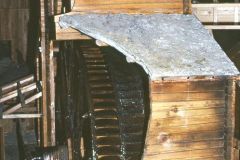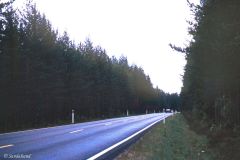The second article from a road trip around southern Norway starts in Molde, continues north around the Trondheim fjord, over the mountains and then south through the long forested valleys to Oslo. The trip is long, but what does it matter when there is so much to discover?
This is one of four articles from a road trip in the four regions of southern Norway. In three weeks we will be driving almost 3,000 kilometres (1,800 miles). It’s an amazing journey, so read up on the introductory article before you proceed.
This article was first published in Norwegian, on Sandalsand Norge.
We are leaving Western Norway
We had left behind us most of Norways’ western region Vestlandet, and made a stop in the town of Molde. From this part of the Romsdal district in the county of Møre og Romsdal, we went further north to Nordmøre and the town of Kristiansund.
It proved to be a pleasant town, so we looked around for a few hours. We had not much time to spend, because we had some distance to cover. We backtracked our route to Vestlandet’s thoroughfare, the E39, and followed it for a few more hours. It was not until Orkanger, not very far from Trondheim that we turned off this road. By now we had entered the county of Sør-Trøndelag.
South and North Trøndelag
The two counties of Sør- and Nord-Trøndelag make up the centre of the Norway’s north-south axis. Over the next couple of days we would cover quite some distance. A large part would be on the Fosenhalvøya (peninsula). This is a large, sparsely populated area north and west of the Trondheim Fjord, with the ocean just beyond. If you favour the roads less travelled, this is where you should come.
At Orkanger we turned north-west on Road 610 until we eventually arrived at a ferry crossing. We were going to cross the outer part of the Trondheim Fjord. On the other side lies Ørland airbase, but it was not tempting objective. We went for the Austråttborgen not far from it. “Borg” means fortress in Norwegian, but would in this context also translate as a fortified manor.
This has been a large, wealthy farm for over a thousand years. There are few remains from the earliest time, and much of what today is kept as museum buildings were built in the 1600s. This applies especially to the manor and chapel. It was all built into a square for protection.
By now we had already been quite a few hours on the road, driving all the way from Molde. Consequently we continued in a northerly direction while looking for accommodation. We found it in Åfjord. Here they were staging some kind of festival so we had a folklore happening as well.
The next day would leave us even longer on the road. We continued our journey north-west on Road 715 to Osen, before the road turned east into Nord-Trøndelag and slightly more inhabited areas.

You will hardly find any more remote place in Norway, than here at Osen at the tip of the Fosen peninsula
.

Over moors, through forests, across streams and rivers and through valleys. Here we are about to enter the Namdalen valley
Some kilometres north of Namdalseid we hit Road 17, and when we came to Steinkjer we turned onto the E6. This is Norway’s parallel to Route 66 in the United States. The E6 runs the entire distance from the south to the very north, and does not stop until it reaches Kirkenes on the border with Russia. We were heading south.
Our goal for the day was Trondheim. There we had relatives who waited, and thus we did the towns of Steinkjer, Verdal, Levanger and Stjørdal injustice. We did not stop. However we felt compelled to make a small detour at Verdal, up to Stiklestad.
Like all Norwegians we had since our childhood been fed with stories about the famous battle that took place here in the year 1030 AD. King Olav Haraldsson was stabbed to death, and lost the battle. However, his death would become the turning point for the introduction of Christianity in Norway. The opposing army disintegrated, Olav was sanctified, and Christianity was finally introduced in Norway. Saint Olav (or St. Olaf if you like) lost the battle, but won the war.
It is picturesque, the countryside here in Trøndelag. For a south-westerner it is kind of strange to witness the long gently sloping fields, not to mention the exceptionally cared-for farms. The traditional long wooden farmhouses are still very well maintained, as with many of the other buildings on the farms. On Jæren in the south-west we mostly let them fall into decay, and build new ones in corrugated iron when they are eventually about to collapse.
Trondheim
Approximately the same architectural atmosphere is found in Trondheim. Here we spent a few days admiring Trøndelag’s old capital. Midtbyen is the name of the city centre. It is also characterized by low, elongated wooden buildings, not too mention the much smaller wooden houses on the other side of the Nidelven river, at Bakklandet.

The Old town bridge with Bakklandet on other side and Nidelven running below
The Old town bridge is the portal of happiness. Together we are sailing in the coral light of stars. Nidelven, how quiet and beautiful you are. Here I am walking and dreaming. (Oscar Hodder)
(The excerpt above is my own translation of Trondheim’s favourite anthem.)
In Trondheim there is of course the Nidaros Cathedral. Norway’s largest cathedral has indeed barely a stone left from the original medieval church where Saint Olav’s relics were kept, but it is beautiful, not least the front that we see partially pictured here.
I’ve mentioned it before in this series, but this road trip took place as far back as in 1993. If you want a more updated presentation of the centre of Trondheim, click this link and watch the video.
Røros, a world heritage
After a few days of rest in Trondheim we were back on the road again. We followed Road E6 south until the road section at Støren. There the E6 continues over Dombås, but we were heading in an easterly direction on Road 30. Støren is beautifully situated on the river Gaula.
Entering old Røros is like walking into a history book, or perhaps rather a fairy tale. Time has stood still since the town was established as a centre of copper mining in the mid 17th century. It should not be missed.
Here one should wander the streets and admire the houses that are legally protected as a national and international heritage site. In one respect Røros is an open-air museum. On the other hand it is an inhabited place even today. The old town centre is in fact a vibrant and active urban environment. Walk up on the hill and soak in the view of slag heaps and the building that has become the icon of Røros, the church.
.
Our road trip took place in the summer. Some years later, I returned in the winter and had the opportunity to stay in one of the listed houses in the centre. It was fun to notice the extent to which the townspeople would use the very special means of transport that we call kicksled. I had brought my skis and set off out of town. It was not many kilometres I had skied until I noticed an unusual sight on a ridge, a herd of reindeer. I had not seen such a herd since I went skiing on the Hardangervidda plateau many years earlier, but there I saw wild reindeer. At Røros we find the country’s southernmost tame reindeer herds.
Back to the present, it is summer and we had borrowed a wooden cabin a few kilometres east of Røros. The road continues towards the border with Sweden, in an area where several of the old mines are found. We visited the Olavsgruva which comes complete with a very interesting museum and a guided tour down the mine. It is strongly recommended.
There were several mines in the Røros region and the activity went on until the 1970s.
Here are some pictures from Røros and thereabouts. Click to see them in a larger version. Read this article about Røros, the World Heritage Site.
The deep forests in Østlandet
We were going further south on our journey around southern Norway. There is great scenery south of Røros. We kept to the east, passing by Femunden, the country’s third largest lake. This must be great hiking country, we thought.
Nevertheless, we were on road trip and had a plan. We followed Road 39 south to Trysil and then turned onto Road 25 towards Elverum and Road 2 towards Kongsvinger. We should have spent longer time on these roads, as we did not fully appreciate the joy and tranquillity of the forests. There were simply too many trees to be appreciated and too many kilometres of endless stretches of forest.

Forest and road, road and forest. All through the Østerdalen valley
This time it was good to arrive at Kongsvinger in the dusk, and admire the view of the country’s largest river, Glomma, from the fortress up on a hill. Kongsvinger is a pleasant town not far from the border with Sweden, and we could easily have spent more time here.
The last leg, to Oslo
This series of articles is structured in such a way that this chapter ends in Oslo, before the next and final chapter takes us along the south coast. Hence there must be included a few words about one of the landscapes of Norway I appreciate the most.
It is hard to come by a more beautiful landscape than the rolling cultural landscape we drive through when we approach Oslo from the north-east, across Romerike. The many beautiful farmhouses are placed on small hilltops, and the fields are very well maintained. In between there is the occasional grove and perhaps a creek down in the hollows between the hills.
When it comes to the country’s premier city, Oslo, I will not explore it here. In fact we came not as tourists, for here we had been living in Oslo for several years and knew the city well. We were heading home to Stavanger, and looked forward to the gentle southern coastal strip of Sørlandet. That last leg of this road trip is described in the next chapter.
Here are the chapters in this series:









































